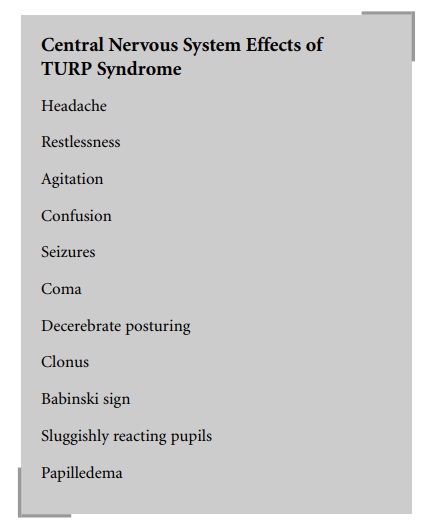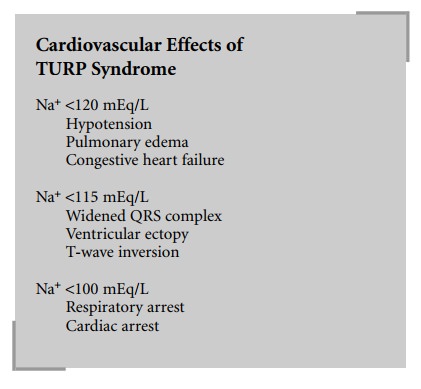Chapter: Clinical Cases in Anesthesia : Transurethral Resection of the Prostate
Describe the TURP syndrome and its treatment
Describe the TURP syndrome and its treatment.
The TURP syndrome is a collection of signs and
symp-toms that occur when excessive amounts of irrigating fluids are absorbed
through the opened prostatic venous sinusoids. This absorption of fluids may
result in water intoxication, hyponatremia, and hypo-osmolality.
The decrease in sodium levels during a TURP
ranges from 3.65 to 10 mEq/L. Several mechanisms for this have been postulated.
Hyponatremia may be due either to simple dilution of the blood by the
irrigating solution or to diffusion of sodium into the irrigating solution at
either the surgical site, or into the periprostatic and/or retroperitoneal
spaces. The degree of hyponatremia is related to the rate of absorption of the
irrigating fluid and not to the absolute amount absorbed.
The effects on the central nervous system
include headache, restlessness, agitation, confusion, seizures, and eventually
coma. These findings are thought to be caused by cerebral edema, with a
concomitant increase in intra-cerebral pressure. As the neurologic condition
worsens, the patient may develop decerebrate posturing, clonus and a positive
Babinski sign. Ocular examination often reveals bilateral dilated and
sluggishly reactive pupils as well as papilledema. Electroencephalogram (EEG)
often shows low-voltage activity. If coma occurs, it usually resolves within
hours to days, but can be permanent. The incidence of neurologic injury is more
closely related to the rate of sodium decrease rather than the degree of
hyponatremia.

Hyponatremia and fluid overload have
deleterious consequences on the heart. The initial cardiovascular effects of
fluid overload include hypertension and brady-cardia. However, serum sodium (Na+)
levels of 120 mEq/L are associated with a negative inotropic effect on the
heart causing hypotension, pulmonary edema, and conges-tive heart failure
(CHF). Serum Na+ levels of less than 115 mEq/L are associated with
electrocardiogram (ECG) changes, such as a widened QRS complex, ventricular
ectopy, and T-wave inversion. When serum Na+ falls below 100 mEq/L,
respiratory and cardiac arrest may occur.
If the patient develops signs and symptoms of
the TURP syndrome, the surgical procedure should be concluded as soon as
possible. Treatment should then be directed at raising the serum Na+
level and correcting the volume overload by fluid restriction and the
administra-tion of a loop diuretic, such as furosemide. In severe cases of
hyponatremia, administration of a hypertonic saline solution (3–5% sodium
chloride) may be necessary. Rapid correction of hyponatremia has been associated
with cerebral edema and central pontine myelinolysis. All other treatment is
dictated by the patient’s symptomatology. Supplemental oxygen should be
considered and the patient may even require tracheal intubation and mechanical
ventilation.

Related Topics